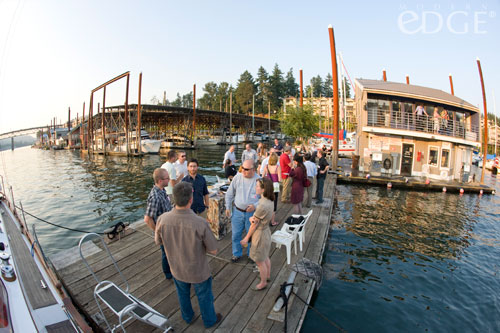Environmentally sustainable design is at a crossroads. The insight and emotion that drove the passionate early adopters is giving way to data-driven decision making. New software tools and design methodologies are gaining traction and the result is a new level of innovation. But there’s still work to do for greener design methodologies to go mainstream. This is the take away from the dialogue on Thursday August 5th, at the Sustainable Minds and Modern Edge design reception at the Modern Edge Studio in PDX. Three main areas of discussion arose:
Credible Greener Decisions:
The question has changed from “How will we save the world?” to “How can we make credible decisions and substantiate progress?” It’s about putting credibility into the process of creating greener design. “Data is the common language; with good data multi-disciplinary teams can quickly come to consensus on the right steps to greener design.” It’s about changing emotion into rational action.
Education + Dissemination:
Of concern was the lack of “greener design” resources for educators and for those in third world economies. Educators and institutions who put practical sustainability tools into the hands of their students are giving them a true leg up in the green economy. As Ann-Marie Conrado of the University of Notre Dame noted, “Greener design needs to be a part of the basic design education curriculum.” In the third world, substantial challenges remain: how do we empower advanced sustainable design in the third world? Not simply re-purposing used goods, but true ground up innovation. Marianne Grisdale of Teams Design pointed out the difficulty of “greener” material sourcing in the third world (and to a certain extent cost factors in the first world). The common thread in this portion of the discussion was that the design information and approaches used at the front end needs to be linked to sourcing realities on the back end.
Consumer Driven Change:
Jennifer Peavy of Eastman noted a common need to “understand the definition of sustainability internally and externally to companies, as all customers and practitioners have varying definitions.” We need to quantify and improve our decision making process. It’s about giving companies tools and standards to share their progress with consumers. Mark Elliot from Yakima rightly commented that consumers do not want to compromise on performance. Change is going to come with market driven factors, so the greener decisions can’t contradict the design performance mission. Designers are in a critical position to see this change through to the next level. Shane MacGregor from Motorola summed up the tipping point: How can we help the customer differentiate what “IS” greener from what is “PERCEIVED” to be greener?
The next steps are up to us. Let’s get moving…

